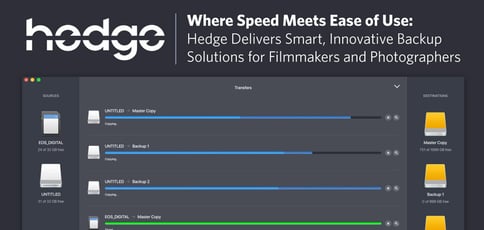
TL; DR: Hedge, a backup software solution for filmmakers and photographers, simplifies data handling so users can focus on their core competencies. The technology is both user-friendly and fast, allowing media professionals to create multiple backups with ease. With the recent acquisition of Postlab, a tool that facilitates collaboration on Final Cut Pro X projects, Hedge is poised to continue to evolve the market while anticipating future customer needs.
Paul Matthijs was working as an audio consultant on the set of a Dutch documentary when he noticed one of the crew members was in a state of panic. The man, who was in charge of data handling, would dart back and forth across the shoot in an apparent attempt to control the chaos of his job.
“I told him, ‘Let’s see if I can help you out,’” he said. “I didn’t have a lot to do, and he was running around sweating all day — and these were very long days.”
Paul automated what he could using AppleScript, which streamlined the crew member’s workflow and eased his anxiety. The results were so impressive that when he went back to work on the set a year later, the crew member wanted to put Paul in charge of data handling altogether.

Hedge eliminates data handling burdens so users can focus on more pressing tasks.
“I accepted the offer — there was good money in it,” he said. “I built more and more AppleScripts, one thing led to another, and before we knew it, we had automated the whole process.”
Five seasons later, Paul had created a custom AppleScript for overnight transcoding and synchronization that could handle a 15-camera shoot filmed 12 hours a day. “Even with today’s standards, that’s a massive production,” he said. “Still, we could get the editors set up within 24 hours.”
After five years, the show ceased production. Paul couldn’t turn what he had created into a local service because large-scale films weren’t common in the Netherlands. He decided, instead, to turn the tools into a product. It wasn’t hard to attract investors, and within six months, Hedge was born, with Paul serving as CEO.
Today, the backup software simplifies data handling, allowing filmmakers and photographers to focus, instead, on their core competencies. Thanks to its ease of use and speed, thousands of media professionals now use Hedge daily.
Simplify Data Handling with Lightweight Yet Powerful Software
Paul said his goal for the company is to make software for Mac and Windows users that’s super easy to use and lightweight with high-tech functionality. In that regard, Hedge takes on the tedious job of offloading media — both stills and audio — with lightning-fast speed.
“We’re trying to bridge the gap between moving a lot of data to actually using that data for some purpose — usually creative, as most of our users are in media and entertainment,” he said. “We also have some customers in remote imaging who need to move a lot of data before processing it.”
Beyond super-fast transfers, Hedge allows users to create as many copies of their files as needed — all at the same time. The software also includes a feature known as Checkpoint that ensures all backups are complete and error-free.

The Hedge team is on a mission to simplify workflows without vendor lock-in.
In addition to transfer logs, Hedge creates a Media Hash List (MHL) for every offload containing information on the files on the disk, their size, location, and checksums. Via Checkpoint, Hedge users can easily verify the integrity of their backups after they’re done.
As powerful as this software is, it’s refreshingly easy to navigate from the perspective of the user. “People sometimes ask for training, and we’d be happy to charge for it, but it’s not necessary at all — it only takes a minute to learn,” Paul said.
The same goes for Canister, the company’s application for Linear Tape Open (LTO) backups on macOS. LTO backups leverage a software counterpart known as the Linear Tape File System (LTFS) that allows users to access and view files stored on a tape. But Paul said it’s extremely difficult to work with.
“With Canister, we found a way around the limitations of LTFS by building a layer on top of it, allowing users to browse a tape without accessing it — and without vendor lock-in,” he said. “We have a manifesto internally, and our main intentions are to make easy-to-use software, commoditize processes, and be last to market — but also never create vendor lock-in for our products.”
Commoditizing a Range of Industry Processes
In addition to being easy to use, Paul told us it can actually be fun to work with products like Hedge and Canister.
“Data handling is not sexy at all, and it’s great to hear almost on a daily basis that users enjoy watching the software,” he said. “For example, big LTO 8 transfers can easily take 24 to 30 hours, so if they start the transfer in the morning, and the next morning get back to the office and it’s still running efficiently, that gives them a smile.”
Users often say they’re very confident using the company’s software — and that confidence gives them the peace of mind to move on to other tasks.
In terms of internal development, Paul said the company has mapped out what customers will need in the future and is very much ahead of the curve.
“We don’t follow market trends, because we tend to be in front of the market,” he said. “Essentially, we are an R&D company — about 90% of what we are working on internally won’t make it to market yet. There are other technologies that we’ve worked on for four years that the industry is finally ready for, and we’re slowly rolling those out.”
Paul said the team behind Hedge isn’t focused on attracting new users — they’re in the business of catering to existing ones. The company’s vision is to further simplify customer workflows, and if a feature doesn’t fit into that vision, it won’t be built.
“We make very opinionated software, and that’s something people like about us,” he said. “We don’t do settings; we don’t do knobs. We don’t do bells and whistles, or space shuttle software, as we call it.”
Ensuring Seamless Integration Between Postlab and Hedge
According to Paul, Hedge streamlines just one of about five steps in the process between shooting a video and editing it. Now, with its recent acquisition of PostLab, the company can simplify the workflow that occurs between backup creation and media archiving.
Postlab currently allows editors to collaborate on Final Cut Pro X projects with version control, file sharing, and commenting. Paul said the company is adding support for other video-editing tools.
“We just opened Adobe Premiere Pro in beta this week, and we want to add all creative apps when possible,” he said. “We’re looking at tools like DaVinci Resolve and Photoshop because we want to cut out all the steps between camera and editor.”
Paul said the new Postlab is a cloud service and desktop application priced for individuals, professionals, and large organizations.
“What we’re working on is this: When you upload a card from a camera, we propagate all the metadata into Postlab, so someone on the other side of the globe can start editing or working on asset management straight away without having the actual footage or files there,” he said. “Ideally, we anticipate a much closer integration between Postlab and Hedge.”
Users can currently choose between three plans. The Postlab plan allows individuals to work on and track 25 libraries, while Postlab Pro supports 250 libraries, includes organization tools, and features 100GB of document storage. Postlab Server, aimed at teams that require Active Directory and single sign on, is a dedicated cloud server with room for more than 2,500 libraries, plus 1TB of documents and granular access management.
Leading the Market While Anticipating Future Needs
Paul said there is an entire range of processes in the media and entertainment industry that Hedge can potentially commoditize to streamline workflows — and the company is always working to increase efficiencies.
Eventually, he said the company would like to eliminate Hedge itself, if possible.
“It’s like what Apple did by killing off their cheap Macs with the iPad,” Paul said. “That was a smart move because otherwise, someone else was going to do it. We are always looking for a way to kill off our own products by creating new ones.”
HostingAdvice.com is a free online resource that offers valuable content and comparison services to users. To keep this resource 100% free, we receive compensation from many of the offers listed on the site. Along with key review factors, this compensation may impact how and where products appear across the site (including, for example, the order in which they appear). HostingAdvice.com does not include the entire universe of available offers. Editorial opinions expressed on the site are strictly our own and are not provided, endorsed, or approved by advertisers.
Our site is committed to publishing independent, accurate content guided by strict editorial guidelines. Before articles and reviews are published on our site, they undergo a thorough review process performed by a team of independent editors and subject-matter experts to ensure the content’s accuracy, timeliness, and impartiality. Our editorial team is separate and independent of our site’s advertisers, and the opinions they express on our site are their own. To read more about our team members and their editorial backgrounds, please visit our site’s About page.

